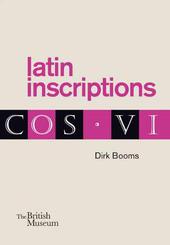
|
Latin Inscriptions
Paperback / softback
Main Details
| Title |
Latin Inscriptions
|
| Authors and Contributors |
By (author) Dirk Booms
|
| Series | Ancient languages |
|---|
| Physical Properties |
| Format:Paperback / softback | | Pages:112 | | Dimensions(mm): Height 210,Width 148 |
|
| Category/Genre | Language - history and general works |
|---|
| ISBN/Barcode |
9780714122885
|
| Classifications | Dewey:471.1 |
|---|
| Audience | |
|---|
| Illustrations |
Illustrated in colour throughout
|
|
Publishing Details |
| Publisher |
British Museum Press
|
| Imprint |
British Museum Press
|
| Publication Date |
9 May 2016 |
| Publication Country |
United Kingdom
|
Description
Latin inscriptions can appear daunting - a jumble of letters without any structure or meaning. However, once you know how, most are easy to read as they follow strict rules of grammar and abbreviation. This book will teach readers how to 'decipher' them and will highlight how even the smallest piece of information that an inscription may provide can help classicists and archaeologists to reconstruct the daily life of ordinary Romans. While surviving literature often only relates to the lives of the elite (who could afford books), inscriptions were texts used by all and meant to be seen by all. Thus, they shed light on the lives of those classes of people less visible in the archaeological record - the poor, slaves and women. Illustrated with the best examples of inscriptions from the British Museum's Roman collection, this book will explore the meaning of putting up public inscriptions and the standardised system of abbreviation that was used to ensure Romans from all areas of the Empire could read them. Written in the simple everyday-life Latin, they also reflect linguistic changes within society, allowing the modern day scholar to uncover the introduction of slang words and new spellings of Latin words. We may also stumble across spelling mistakes, for not everyone knew how to write Latin fluently, and often we find that words had been written phonetically. If the text of the inscriptions can give us one part of the information, often the style of decoration around the inscription, the accompanying images, or the original location can tell us even more. Every aspect of an inscribed monument was carefully chosen by the person commissioning the inscription, and thus carried specific meaning, and so combined with the texts of the inscriptions, it is possible to reconstruct pieces of the lives of everyday Romans that were thought most valuable to be remembered.
Author Biography
Dirk Booms is a curator of Roman archaeology at the British Museum. He has special interests in Roman architecture, sculpture, glass and inscriptions and is co-author of Roman Empire: Power and People (British Museum Press, 2013).
|